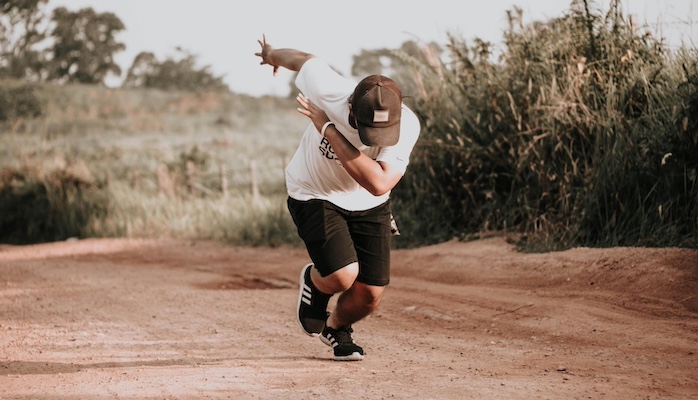
Generally, episodes of lower back pain caused by a muscle strain or other soft tissue injury get better within two to three weeks. Suppose pain lasts longer than that the patient may want to be evaluated by a spine specialist. This would give them some time frame.
Herniated Disc
A herniated disc is a condition where the disc itself has begun to bulge or rupture and begins to put pressure around a nerve.
This condition can be inflamed again by repetitive exercise such as running, and symptoms may progress to sciatica, which is a pain down the leg associated with numbness and tingling. If an athlete begins to develop these kinds of symptoms, particularly numbness, weakness, or pain in the leg, they should quickly be evaluated by a spine specialist. These types of symptoms often will mandate an MRI to better evaluate the health of the lumbar discs. If a herniation is seen, the patient will usually be advised to stop high-impact activities such as running or jogging. Physical therapy and cortisone-type injections may be useful to help with symptom relief. Changing the workout to non-impact type exercises or lower-impact exercises, may also be helpful.
Examples of low-impact aerobic exercises for lower back pain include:
- Elliptical trainer
- Biking, or stationary biking
- Exercise walking (or walking on a treadmill)
- Water therapy for pain relief or pool therapy
- Swimming
For cases of progressive sciatica (leg pain) where a disc is significantly impinging on a nerve, surgery may be considered. Surgery in these cases involves a microdiscectomy-type approach, where a small fragment of the disc is removed away from the nerve. This tends to be a very successful surgery in terms of relief of the leg pain and return to athletic activity.
The majority of athletically active patients who have a microdiscectomy to relieve nerve root irritation will return to their pre-injury level of performance, assuming that they have not sustained nerve damage from the injury. That is why it is important to obtain an evaluation in a timely fashion if neurological symptoms, such as progressive leg weakness or numbness, develop.
A condition called foot drop is of particular concern. This occurs when an individual begins to experience weakness or loss of strength in the leg, losing the ability to raise the foot at the ankle. In the long term, this type of condition can be very debilitating and surgery may be considered more urgently to minimize or avoid nerve damage.
Degenerative Disc Disease and Spondylolisthesis
Symptoms from both degenerative disc disease (DDD) and spondylolisthesis (spongy), which may occur together, can also be exacerbated by running.
- Degenerative disc disease occurs when the disc loses some of its cushioning/shock-absorbing capacity
- Spondylolisthesis is a slippage of one vertebra on another which is a form of spinal instability.
Over time with repetitive stress from regular running or jogging, either or both the degenerative disc and/or spondylolisthesis conditions can become increasingly symptomatic. These conditions are more likely to affect older athletes, in the range of 40 to 60 years old.
Again, if increasing lower back pain and/or sciatica develops after running, the individual is usually advised to change to a lower-impact form of exercise and have a spinal evaluation. Sometimes |symptoms of degenerative disc disease and/or spondylolisthesis can be alleviated by core strengthening and proper exercises, and perhaps wearing an athletic brace. Sometimes the condition progresses and requires more progressive intervention in the form of back surgery. Again, these decisions are symptom-driven, often based on neurological status.
Other conditions that can be inflamed by running include arthritic conditions of the lower back, such as arthritis or spinal stenosis.
Precision Pain Care and Rehabilitation has two convenient locations in Richmond Hill – Queens, and New Hyde Park – Long Island. Call the Queens office at (718) 215-1888 or (516) 419-4480 for the Long Island office to arrange an appointment with our Interventional Pain Management Specialists, Dr. Jeffrey Chacko or Dr. Sonny Ahluwalia.















